The much-anticipated Danjiang Bridge (淡江大橋) is scheduled to open for traffic on May 12 next year after the final bridge segment was successfully installed yesterday, the Ministry of Transportation and Communications said yesterday.
President William Lai (賴清德) and other officials attended a ceremony yesterday, in which they witnessed the closure of the main bridge span.
The bridge, which connects New Taipei City’s Tamsui (淡水) and Bali (八里) districts, would help ease the traffic on Guangdu Bridge (關渡大橋) by 30 percent and that on Highway No. 2 by 17 percent, Lai told the participants at the ceremony.
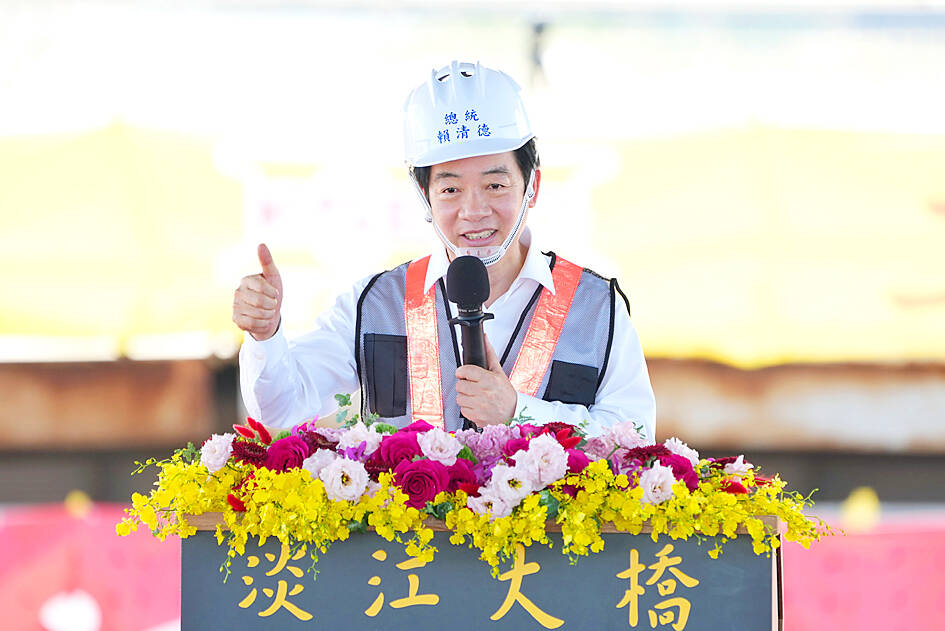
Photo: Chen Yi-kuan, Taipei Times
It would also facilitate journeys to New Taipei City’s Linkou District (林口), downtown areas in Taipei and New Taipei City, and Taiwan Taoyuan International Airport, he said.
Designed by the late Iraqi British architect Zaha Hadid, the bridge would serve not only as transportation infrastructure, but also as an architectural work of art, Lai said, adding that the bridge design was inspired by dances performed by Taiwan’s Cloud Gate Dance Troupe and the sunset at Tamsui.
CNN has listed the bridge as one of the top 11 architecture projects set to shape the world this year, he added.

Photo: Chen Yi-kuan, Taipei Times
The architecture demonstrates the resilience and spirit of Taiwanese, and skillfulness of the construction team, Lai said.
“The Highway Bureau failed to secure contractors after seven tenders due to the technical challenges of building a single-pylon cable-stayed bridge with a tower curving in all three dimensions. Some had suggested a two-dimensional tower be built. Fortunately, the government decided to follow the original bridge design. It would be an embarrassment if Taiwanese could not fulfill the vision of a world-class architect,” he said.
Danjiang Bridge will be the first landmark that air travelers see when they fly over the area, he said.
Aside from Danjiang Bridge, Lai also pledged to support the construction of Tambei Highway (淡北道路) and Tamhai Light Rail (淡海輕軌), although he said that local governments might not receive much subsidies from the central government as they used to following the approval of amendments to the Act Governing the Allocation of Government Revenues and Expenditures (財政收支劃分法).
“Local governments would have to shoulder more responsibility now they have more funding at their disposal. I hope that both the ruling and opposition parties work together to find solutions to the problems with the act to ensure balanced and sustainable development of different localities,” Lai said.
Minister of Transportation and Communications Chen Shih-kai (陳世凱) said the ministry nearly gave up on the project, but it was able to proceed because of the perseverance of then-Highway Bureau director-general Chen Yen-po (陳彥伯), who is deputy minister of transportation and communications, and Lai, the then-premier, he said, adding that the Executive Yuan in 2018 raised the budget for the project to NT$21.2 billion (US$704.3 million) from NT$15.4 billion, with the funding allocated to build the main bridge section rising to NT$12.5 billion from NT$8.4 billion.
Following the installation of the final segment, the bridge deck at the Bali end would be 120cm lower than that at the Tamsui end, which is normal, he said, adding that the bridge deck would subsequently be lifted with stay cables to level it out.
Every weld on the bridge was carried out according to the same standards used in nuclear power plant construction, he said.
The construction team aims to meet the criteria to open the bridge for traffic by April next year, the Highway Bureau said.
Between now and April, the team would still need to lay the dense asphalt concrete, adjust the cable force, install landscape lighting poles, noise barriers and other auxiliary facilities, and conduct bridge structural load tests, it said.
The total project budget would be NT$23.038 billion, with the New Taipei City Government covering NT$8.566 billion, including NT$1.33 billion for the Danhai MRT extension. The remaining costs are to be shared by the Ministry of Transportation and Communications at NT$7.237 billion and the Ministry of the Interior’s National Land Management Agency at NT$7.236 billion.
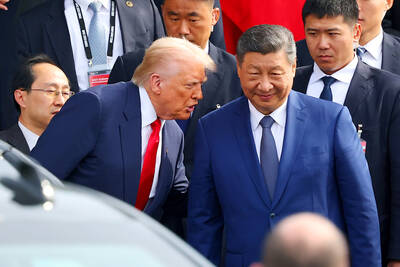
UKRAINE, NVIDIA: The US leader said the subject of Russia’s war had come up ‘very strongly,’ while Jenson Huang was hoping that the conversation was good Chinese President Xi Jinping (習近平) and US President Donald Trump had differing takes following their meeting in Busan, South Korea, yesterday. Xi said that the two sides should complete follow-up work as soon as possible to deliver tangible results that would provide “peace of mind” to China, the US and the rest of the world, while Trump hailed the “great success” of the talks. The two discussed trade, including a deal to reduce tariffs slapped on China for its role in the fentanyl trade, as well as cooperation in ending the war in Ukraine, among other issues, but they did not mention
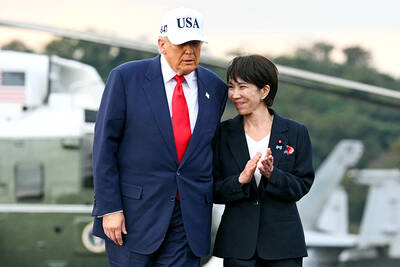
Japanese Prime Minister Sanae Takaichi yesterday lavished US President Donald Trump with praise and vows of a “golden age” of ties on his visit to Tokyo, before inking a deal with Washington aimed at securing critical minerals. Takaichi — Japan’s first female prime minister — pulled out all the stops for Trump in her opening test on the international stage and even announced that she would nominate him for a Nobel Peace Prize, the White House said. Trump has become increasingly focused on the Nobel since his return to power in January and claims to have ended several conflicts around the world,
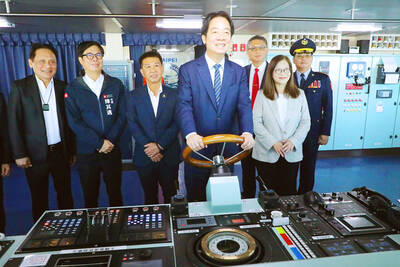
CALL FOR SUPPORT: President William Lai called on lawmakers across party lines to ensure the livelihood of Taiwanese and that national security is protected President William Lai (賴清德) yesterday called for bipartisan support for Taiwan’s investment in self-defense capabilities at the christening and launch of two coast guard vessels at CSBC Corp, Taiwan’s (台灣國際造船) shipyard in Kaohsiung. The Taipei (台北) is the fourth and final ship of the Chiayi-class offshore patrol vessels, and the Siraya (西拉雅) is the Coast Guard Administration’s (CGA) first-ever ocean patrol vessel, the government said. The Taipei is the fourth and final ship of the Chiayi-class offshore patrol vessels with a displacement of about 4,000 tonnes, Lai said. This ship class was ordered as a result of former president Tsai Ing-wen’s (蔡英文) 2018
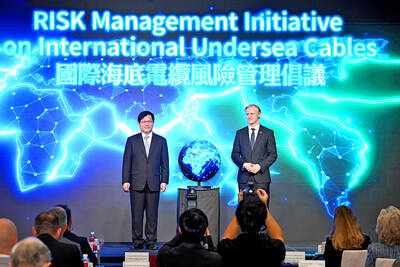
GLOBAL PROJECT: Underseas cables ‘are the nervous system of democratic connectivity,’ which is under stress, Member of the European Parliament Rihards Kols said The government yesterday launched an initiative to promote global cooperation on improved security of undersea cables, following reported disruptions of such cables near Taiwan and around the world. The Management Initiative on International Undersea Cables aims to “bring together stakeholders, align standards, promote best practices and turn shared concerns into beneficial cooperation,” Minister of Foreign Affairs Lin Chia-lung (林佳龍) said at a seminar in Taipei. The project would be known as “RISK,” an acronym for risk mitigation, information sharing, systemic reform and knowledge building, he said at the seminar, titled “Taiwan-Europe Subsea Cable Security Cooperation Forum.” Taiwan sits at a vital junction on